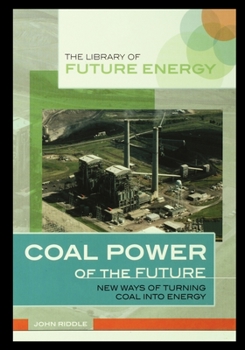Coal Power of the Future: New Ways of Turning Coal Into Energy
Select Format
Select Condition 
Book Overview
Because the United States has had an ample supply of coal, it became a primary source of fuel and energy. But scientists have discovered that burning coal releases sulfur and other materials that,... This description may be from another edition of this product.
Format:Paperback
Language:English
ISBN:1435889207
ISBN13:9781435889200
Release Date:March 2003
Publisher:Rosen Publishing Group
Length:68 Pages
Weight:0.30 lbs.
Dimensions:0.2" x 7.0" x 10.0"
Age Range:12 to 17 years
Grade Range:Grades 7 to 12
Customer Reviews
1 rating
Kyoto Clean Development Mechanism - Carbon Brokering
Published by Thriftbooks.com User , 16 years ago
. A power generator burns about one pound of coal to make one kilowatt hour of electricity. 2. Coke, a byproduct of burnt coal is composed of small amounts of hydrogen, nitrogen, sulfur, and oxygen. Coke is used in steel production. 3. In 1918 coal production reached 678 million tons; in 1994 coal production reached a high of 683 million tons and 688 million tons in 1947. Railroads switched to diesel fuel, reducing their coal consumption to 62 million tons in 1973. The rise of oil and natural gas also impact coal usage so by 1973 coal usage had dropped to 11 million tons. The Yom Kippur War of 1973 caused a retaliatory reaction by OPEC, cutting its oil production by five million barrels a day and causing oil prices to increase 400 percent in six months. "Just before the 1973-1974 oil embargo, the abundance of cheap fuel oil and growing interest in nuclear power threatened the future of coal." The use of coal had declined to 18 percent and oil consumption and natural gas used had increased in relative importance. "Investors had been losing confidence in coal." Demand for electricity increased six fold between 1950-1973. "With the oil embargo of 1973-1974, the demand of coal surge from 92 million tons to 389 million tons a year". Coal was to be the fuel of the future. In 1999, the US consumed 1 billion tons of coal and coal consumption is predicted to be 1.3 billion tons by 2020. 4. Coal generates 51 percent of total US electricity in 1999. Today there are 600 coal fire plants providing electricity. 1,200 new power plants will need to be built by 2020. 5. Natural gas replacement of coal is expected to cause slight drops in coal consumption. Consumption of coal in Canada and Mexico is project to rise from 77 million tons in 1999 to 93 million tons in 2020. Asian countries use 36 percent of the worlds coal in 1999. China consumes 23 percent of the coal. US coal technology will be sold to China and India which have large coal reserves for electricity generation. Coal consumption in Europe will drop over concern about the environmental impact of coal. Europe will migrate towards alternative fuels like solar and nuclear power. 6. Fly ash, the black soot can be removed by devices called precipitators. Today, 95 percent of sulfur oxides can be removed from coal production emissions. EPA estimates that sulfur dioxide emissions from electric utilities have gone down 18 percent since their peak in 1973. 7. The Clean Coal Technology demonstration program was established in 1985. CCT primary goal was to bring industry, universities, and state and federal agencies together to clean up coal emissions while preserving cheap, clean coal to benefit the economy with affordable energy. Electricity must remain abundant and cheap to allow US companies to produce profitably in a competitive world. If electricity becomes to expensive, companies will move to countries where electricity is cheap and regulate non existent. CCT us expected to create a $480 billio





